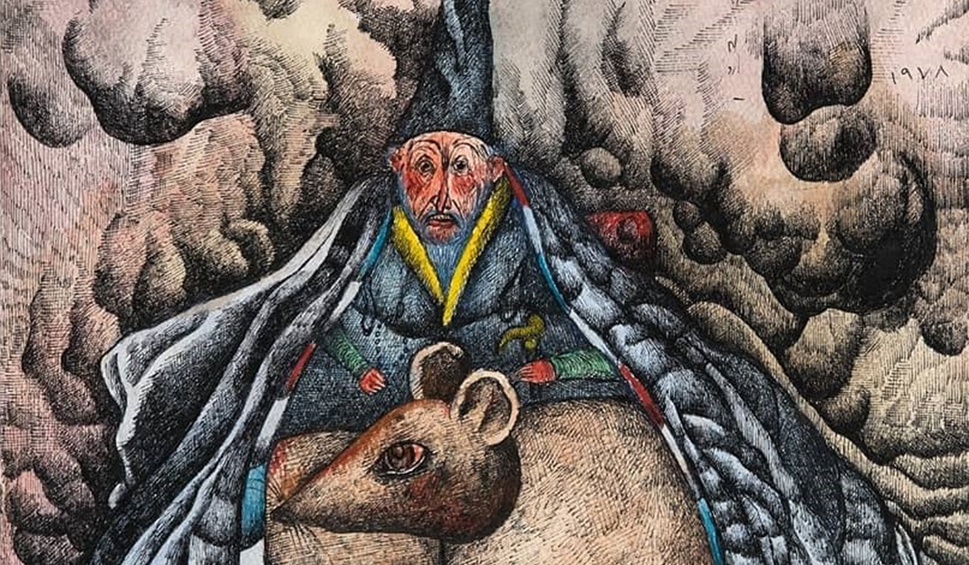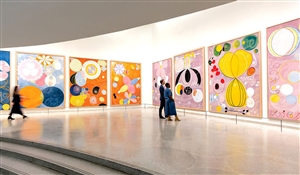A Note on Three Works by Ardeshir Mohassess
31 Jan 2023Original text in Farsi by Tarannom Taghavi
Translated to English by Omid Armat
Studies About the Treasury of Tehran's Contemporary Museum of Arts
This series of notes aim at introducing Iranian artists' works stored in TMOCA's treasury.
Tehran's Museum of Contemporary Arts, established on 13 October 1977, is the oldest institution for modern art in the middle east and one of the first buildings specifically constructed to present modern and contemporary art worldwide. At the time of construction, there were only a few buildings planned to become a museum for modern art; Berlin's National Gallery in Germany had been found only eight years earlier, and the Museum Ludwig in Cologne, whose architecture is similar to TMOCA's, was built eight years later, in 1986. The Museum of Modern Arts at the Centre Pompidou in France was also founded one year earlier. Even today, there is no significant building specially built to display works of modern art throughout the middle east; there are only small galleries or buildings converted to be used mostly for presenting and selling artworks, but not museum shows. (Sami Azar, 2014: 240, 241)
TMOCA may be known, more than anything else, for its series of works by foreign artists. However, the museum's treasury also consists of exquisite works by Iranian modernist artists, such as Iran Darroudi, Sohrab Sepehri, Bahman Jalali, Aydin Aghdashloo, Fereydoun Ave, Alireza Espahbod, Charles Hossein Zenderoudi, Hannibal Alkhas, Parvaneh Etemadi, Zahra Rahnavard, Faramarz Pilaram, Parviz Tanavoli, Sadegh Tabrizi, Jazeh Tabatabai, Mahmoud Javadipour, Mehdi Sahabi, Koorosh Shishegaran, Masoud Arabshahi, Jalil Ziapour, Behjat Sadr, Mansour Ghandriz, Monir Farmanfarmaian, Leyly Matine Daftary, Ali Golestaneh, Hossein Mousavi, Bahman Mohassess, Morteza Momayez, Mohsen Vaziri Moghaddam, Serkis Vaspour, Manouchehr Yektai, Ali Akbar Sadeghi, and others. The gathering of these works started before the Iranian revolution and continued afterward.
- In this note, we will study artworks by Ardeshir Mohssess (1938-2008).
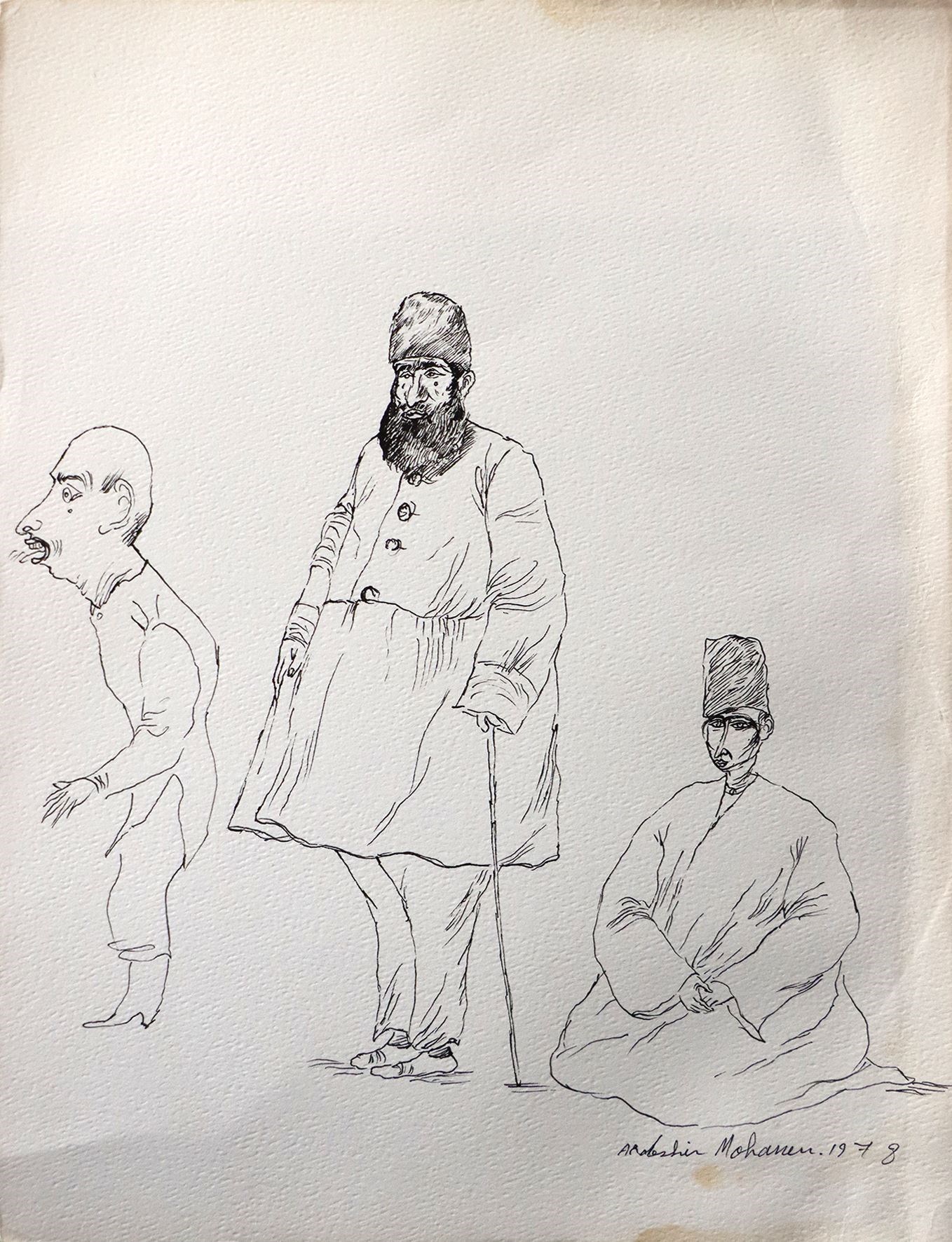
Ardeshir Mohassess | Untitled | 1978 | ink on cardboard | 30 × 23 cm
By publishing his works in "Towfiq" magazine in the 1950s, Ardeshir Mohasses became known as a caricature artist. After participating four editions in Tehran's Biennial (1958, 1960, 1962, 1964), he was also considered among the modernist artists. In 1962, his drawings, titled "Shir-Dokhtaran," were published in The Book of the Week journal under Ahmad Shamloo's administration. After the journal was closed in 1963, Mohassess started working at "Kayhan" daily, producing works for the "Art and Thoughts" page and Ali Asghar Haj Seyed Javadi's social and political articles.
His first solo exhibition was held in 1967 at Ghandriz Gallery with a statement written by Shamloo. In 1969, he presented his caricatures at Seyhoun Gallery. 1970 and 1971 were the period during which Mohassess passed Iran's borders and introduced his works to international audiences; he participated in a group exhibition at The American Institute of Graphic Arts in New York and another group show at Musee des Arts in Paris, which established his position as an international artist.
In 1971, Sirous Tahbaz printed "Cactus," a series of works by Mohassess, in a book called "Notebooks of the Time" with an introduction written by Karim Emami. Mohassess arranged three solo shows during 1971 and 1972 at Seyhoun Gallery, Tehran Municipality Club, and Iran-America Society, then moved to France. He also displayed his works in several solo and group shows from 1973 to 1976, participated in Art Basel (1976), and finally, after joining a group show called "Iranian Modern Arts" at Iran-America Society and displaying his works at Iraj Zand Foundation in Tehran, he moved to the US in 1977 and lived there for the rest of his life.
Attempting to promote his works, Mohasses published his paintings in 11 books during the 1970s. "With Ardeshir Mohassess and His Masks" (1971), including his drawings created between 1967 and 1971, with an introduction written by Ali Asghar Haj Seyed Javadi, "Ardeshir and the Stormy Weather" (1973), including his drawings created between 1967 and 1973 with an introduction written by Ali Asghar Haj Seyed Javadi, "Formalities" (1973) including a selection of his works produced in 1973 with a foreword written by Aydin Aghdashloo, "Birth Certificate" (1973) including a selection of his works created in 1972, "Vaghaye-e Ettefaqiyeh" (1973) including a selection of his works created in 1971 with an introduction written by Ahmad Shamloo, "Free Drawings," "Blasphemy," "Preface," and "Congratulations" are among his books. His caricatures were published for many years in the most influential magazines in the US, like New York Times, The Nation, Washington Post, New Yorker, and "Idea" magazine in Tokyo. More than 70 of his works are stored in the Library of Congress in the US, and some others are in the Metropolitan Museum of Art, the British Museum, Jahan Nama Museum of Niavaran Complex in Tehran, TMOCA, and Nations' Art Museum of Sa'dabad Complex in Tehran.
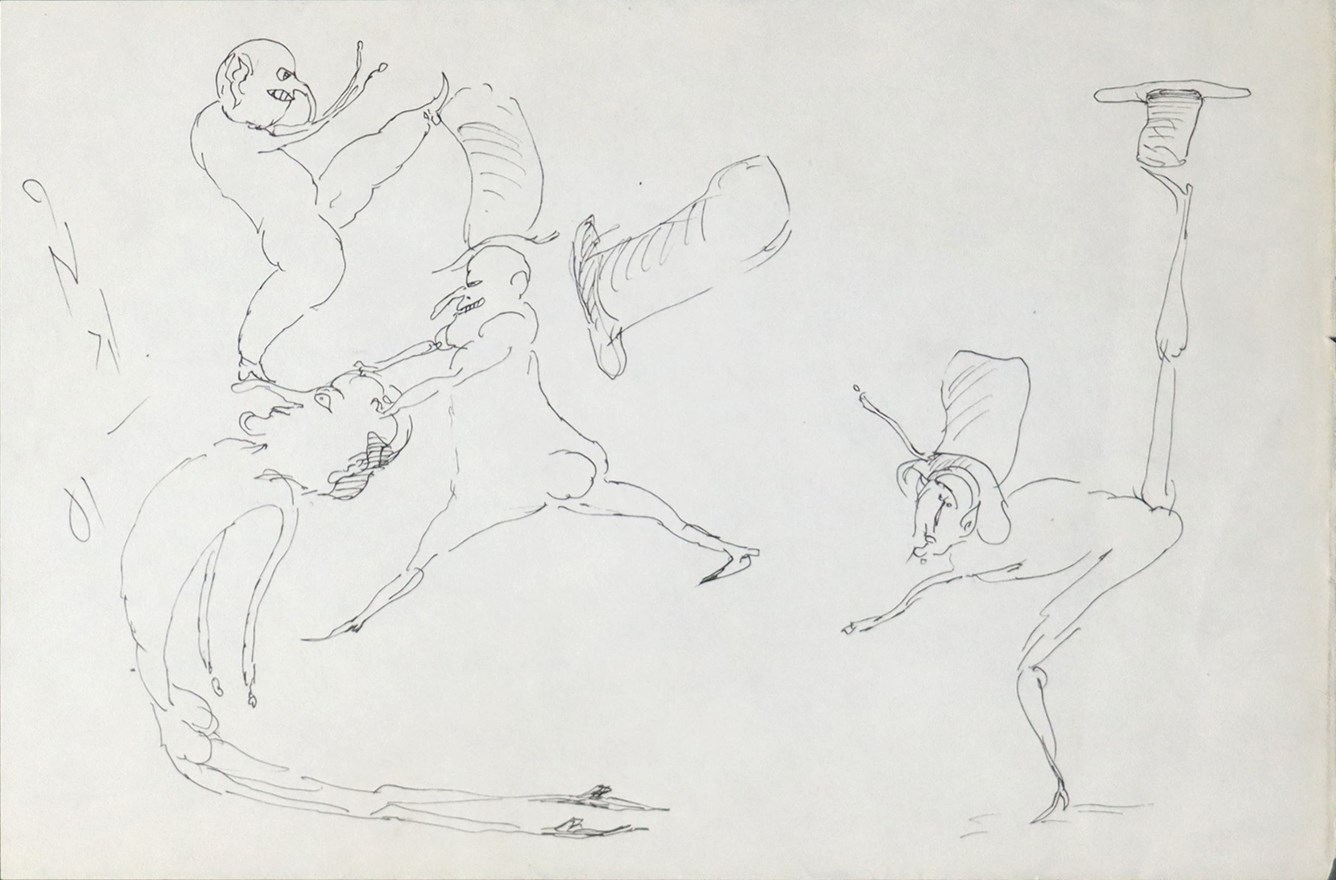
Ardeshir Mohassess | Untitled | 1972 | rapid on paper | 21 × 31 cm
In addition to Iranian Miniature paintings, old photographs of the Qajar Dynasty, and illustrations in lithographed books, Mohassess was influenced by western contemporary artists like Roland Topor (1938-1997),Ronald Searle (1920-2011), Rene Magritte (1898-1967), Saul Steinberg (1914-1999), and David Levine (1926-2009). He was also inspired by Franz Kafka, Eugene Ionesco, Nikolai Gogol, and Graham Greene. In his works, one can see a critical view of human's negative features, degenerate social relations, bureaucracy, and tyranny of rulers, expressed in a grotesque tone and irony. "Among countless realities he saw around himself; he cared more about the humans, their actions and relationships, the reasons and corrupted systems leading to unhealthy relationships. He was interested in revealing contradictions between the behavior and personality in the dual existence of humans, or uncovering realities that were ugly and unhuman to him" (Boghraei, 2015: p. 102). To express his critical thought, Mohassess referred to Qajar images and borrowed from their form and content to recreate them in a new medium.
"Through drawings full of dark comedy and detailed hatchings depicting displacement of different parts of the human body, he presents his sharp critical view on the Qajar dynasty. In some of his works, it is clear that the chronicle of Qajar's flattery and iconography is nothing more than an allegory to him. He depicts a drama opposed to the process of modernity, among characters and rituals as signs of Qajar traditions. His drawing-like caricatures indicate his resistance against the monstrosity of the time, bureaucracy, class discrimination, etc., none of which are formed following humanism; characters that wear luxurious, steel clothes while they don't even deserve to be alive; or enlightening characters who have become captive to the glamour and rituals of Qajar, in a way that their honor medals don't even let them breathe" (Amani, 2022: p. 8).
Artworks by Mohassess that are currently being preserved at the treasury of TMOCA were created during the 1970s and purchased by the museum in 1977 and 1978. We will study three of his paintings that share the same subject and present an ironic interpretation of Sani al Mulk's paintings of Qajar statesmen.

Abu al Hassan Ghaffari | image of Mohamad Shah Qajar | 1881 | watercolor on paper and Abu al Hassan Ghaffari | Portrait of Haji Mirza Aghasi | 1262 | watercolor on paper
By producing an oil painting of Mohammad Shah (1879), Mirza Abu al Hassan Khan Ghaffari Kashani (1850-1904), also known as Sani al Mulk, was accepted as a member of the court painters. He traveled to Italy in 1884 and stayed there for about four years. When he returned to Iran, he became the painter of Naser al-Din Shah's court. Mirza Abu al Hassan Khan Ghaffari Kashani was awarded the Sani al Mulk title in 1898 by Naser al-Din Shah because of his efforts as an illustrator at Iran's Eminent Government daily. Portraits of statesmen during Naser al-Din Shah's period with a precise representation of their outer appearance and inner states were among his artistic productions. Except for Mohammad Shah (first image), Haj Mirza Abbas Iravani, also known as Haji Mirza Aghasi (1819-1886), Mohammad Shah's chancellor, was among the people whose portrait was created by Sani al Mulk (second image).
About a decade after these paintings were created, Ardeshir Mohassess, inspired by body transformations in One Thousand and One Nights tales, and influenced by Cat and Mouse stories in Persian literature, sharply criticized policies of the Qajar dynasty and statesmen and also the whole discourse of power.
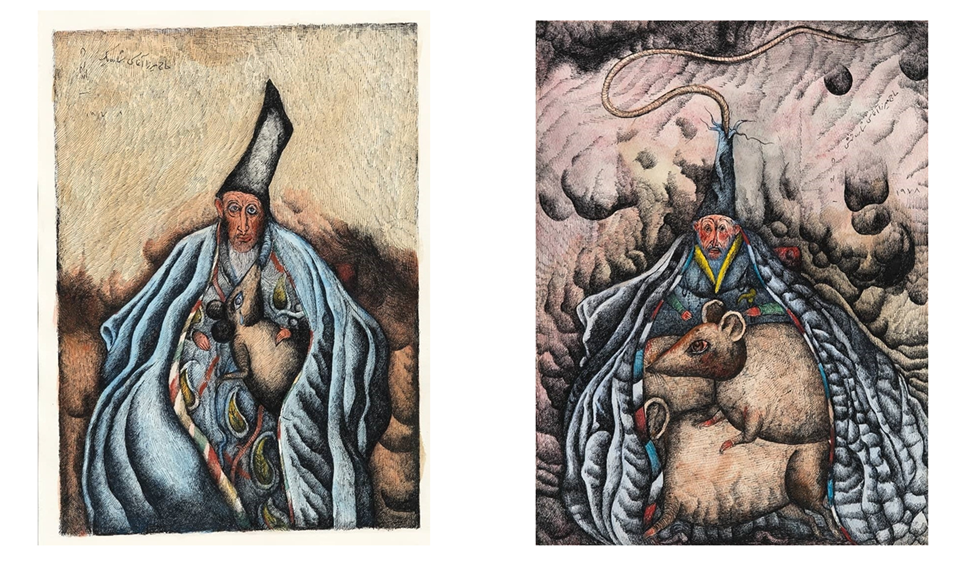
Ardeshir Mohassess | Haj Mirza Aghasi No. 6 | 1978 | TMOCA's treasury and Ardeshir Mohassess | Haj Mirza Aghasi No. 1 | 1978 | TMOCA's treasury
In the third image, an icon of Haji Mirza Aghasi is rendered with a small face, red cheeks, and a fat body covered with three mice placed under his robe, designed with patterns of stones colored grey and white to contrast with his surrounding rocks, while a long mouse tail sticking out of the split tip of his hat.

Ardeshir Mohassess | Based on Sani al Mulk's style 1977 | treasury of TMOCA
Mirza Aghasi's face and body are depicted more realistically in another image. A mouse is lying on its back, looking at him under his robe, while a teardrop is coming out of its eye.
In an ironic interpretation of the first image, a cat is depicted in the appearance of a king, sitting on a royal throne, with a red face and long mustache, while wearing a dress decorated with emerald buttons, green broadcloth pants, and long hat with a paisley ornamented with a jewel.
In Persian literature and semiotics, the mouse is a sign of extreme precaution, espionage, greed, theft, guile, and jealousy.
In contrast, the cat signifies mysterious forces, deception, and hypocritical asceticism. From the cat-and-mouse stories of Kalila and Dimna and Marzban-name to the cat-and-mouse stories by Ubayd Zakani and Sheikh Bahai, one can understand that they are all attempting to present an allegorical image of the relationship between humans and the deceptions hidden in their thoughts while representing the duality of the human's spirit and nature. This allegory, in the artful hands of Mohassess, has turned into a tool for social and political criticism where Haji Mirza Aghasi's face is sometimes transformed into a mouse face, and sometimes a mouse tail sticks out of his robe.
Executing his images differently than Sani al-Mulk's paintings, Mohassess used detailed, intertwined hatches and changed the spiritual tenderness of the light on the Qajar statesmen's faces to a violent one staring at the viewer. Mohassess had once said about his works: "I don't consider life to be funny {…} I depict the particular relations through the catapult-like pressure of which humans become a scum of their existence and when the border between their human features and wild instincts collapses."
Sources:
-
Amani, Hojatollah (2022), "neo-Qajarism in Iran's Modern and Contemporary Visual Arts", The Eastern Art and Civilization Magazine, 10th year, Vol. 25, p. 5-12.
-
Boghrati, Faegheh (2015), "Ardeshir Mohassess and Modern Satire", Herfeh Honarmand, No.54, p. 100-105.
-
Diba, Kamran (2014), "Mirror of the Time; Kamran Diba and Tehran Museum of Contemporary Art", In a Garden Between Two Streets: Four Thousand and One Day of Kamran Diba’s life in an interview by Reza Daneshvar, Tehran: Bongah.
-
Rastegar Fasaei, Mansour (2009), Body Transformation in Mythology, Tehran: Institute for Humanities and Cultural Studies.
-
Sami Azar, Alireza (2014), "Mirror of the Time; Kamran Diba and Tehran Museum of Contemporary Art", In a Garden Between Two Streets: Four Thousand and One Day of Kamran Diba's life in an interview by Reza Daneshvar, Tehran: Bongah.
-
ewikitl.top/wiki/Ardeshir_Mohasses
-
darz.art/fa/artists/ardeshir-mohassess
Cover and slider image:
- darz.art



